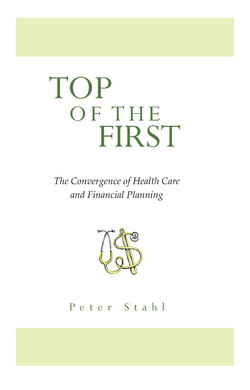Читать книгу Top of the First 2016 - Peter Stahl - Страница 4
Оглавление2016 Medicare Part A 1
Medicare Part A primarily covers three services:
1. Hospital Coverage:
Days 1-60: full coverage
Days 61-90: you pay $322 per day coinsurance
Days 91+: you pay $644 per day coinsurance while using 60 life time reserve days
2. Skilled Nursing Facility (for a qualified stay):
Days 1-20: full coverage
Days 21-100: you pay $161 daily deductible
Days 101+: no coverage
3. Hospice Care:
Care one receives in the final stage of life: full coverage
Part A does have a deductible ($1,288 per benefit period) for year 2016. It is important to note that this deductible, as well as some of the coinsurance listed above can be covered under a “Medigap” plan, which will be described later in this chapter.
Medicare Part A receives its funding from a couple of sources. The first source is a payroll tax of 2.9%. The employee and the employer split the tax evenly each paying 1.45%. Beginning in 2014, the Patient Protection Affordable Care Act introduced two additional taxes for couples earning over $250,000 or single filers earning over $200,000. The first is an added .9% tax on earned income. The second is a 3.8% tax on net investment income.2 If your income is close to these levels, discuss this tax with your financial advisor and tax professional. If you are able to manage income flows, capital gains, and utilize tax favored investments to keep you below these income thresholds, the tax savings are meaningful.
Since the funding for Part A is provided by the aforementioned taxes, there is no direct cost for this insurance when one becomes eligible and enrolls. Most people are eligible and enroll in Medicare Part A when they reach age 65. The most common way to know that you are eligible for “free” Part A coverage is if you qualify for Social Security benefits. There are special considerations for those who need Part A due to a disability prior to age 65. You may wish to delay your enrollment in Part A beyond age 65 if you have creditable coverage from an employer health insurance plan. This is most common when one desires to continue funding into a Health Savings Account. This strategy will be discussed in chapter 4.
For a full description of enrollment and eligibility, visit Medicare.gov.
Medicare Part B 3
Medicare Part B, your doctor and outpatient services coverage, handles two types of services.
Medically necessary services: Services or supplies that are needed to diagnose or treat your medical condition and that meet accepted standards of medical practice.
Preventive services: Health care to prevent illness (like the flu) or detect it at an early stage, when treatment is most likely to work best.
Medicare B has a $166 (2016) annual deductible, 20% coinsurance (with no limit), and a monthly premium based on your income.3
Most people pay the Medicare Part B premium with a deduction directly from their Social Security benefit. Since Medicare is now mandatory, this reduction from your retirement income stream can be delayed but is ultimately, unavoidable. The amount of your 2016 premium is based on your 2014 income (Modified Adjusted Gross Income) meaning “higher” income earners will have a substantially higher premium (see chart below). This is referred to as an Income Related Monthly Adjustment Amount (IRMAA). To put it more plainly, it is a tax. Once again, the IRMAA tax is an extra charge added to your premium.
